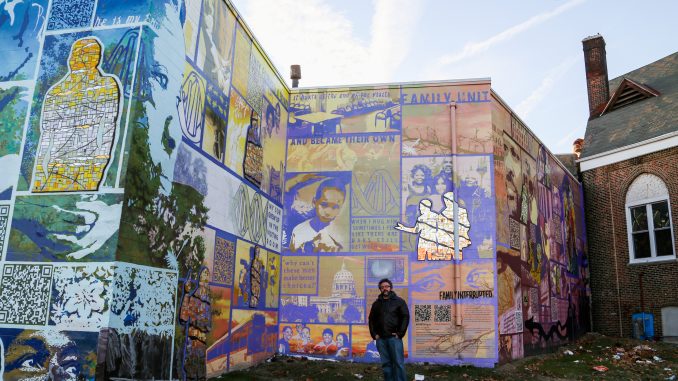
Eric Okdeh teaches art classes to about 15-20 students with the Mural Arts Program. The Philadelphia-based muralist, however, isn’t just teaching his pupils about muralism.
His class, part of Mural Arts’ Restorative Justice Program, teaches mural art-making to inmates from Pennsylvania’s Graterford Prison.
“These guys have the ability to give back,” said Okdeh, a Tyler School of Art graduate. “I’m going into a prison and I’m meeting guys who found out they were artists in prison.”
On Jan. 29, a new exhibit titled “Beyond The Wall,” opened at the third floor of the Philadelphia Art Alliance. The white walls of the exhibit housed creations by a group of people not typically referred to as artists, but as inmates.
Okdeh said he works with the participants as “the conduit to create something great and be a part of something much larger.”
As the director of the program, Robyn Buseman said that after talking to inmates at Graterford, she developed the idea to use art as a way to raise awareness for mass incarceration.
Buseman said Mural Arts wanted to get people talking about why America has more people in prison than any other country in the world. Pennsylvania is one of the leading states in the number of incarcerated individuals.
“We talked to the men that are incarcerated [at Graterford], as well as the community,” Buseman said. “We talked to lawyers, judges, inmates, guards, police officers and people who just came out of jail [asking], ‘What’s going on in this country?’”
According to the National Institute of Corrections, the jail census reported in 2013 that Pennsylvania’s average of incarcerated is 391 individuals per 100,000 people. The national average is 395 incarcerated persons.
Amira Mohamed, one of the many subjects represented in the exhibit, served about seven years in prison for a crime she chose not to disclose.
“I came home August of last year after serving a year for parole violation,” Mohamed said. “I checked my email from months ago where [Buseman] was mentioning this program. I reached out to her and asked if I had missed it and she said ‘No.’”
The piece she was represented in expresses that she realizes inmates know there is a “small margin of error” when they come home.
“We all reach 1,000 closed doors before that 1,001st door finally opens,” Mohamed said.
Temple alumna Abigail Henson and criminal justice professor Sharon Ostrow were among the 40-plus guests at the exhibit opening.
“When you realize that 95 percent of incarcerated individuals are returning from the community, the importance of empowerment, creative expression and self-awareness becomes paramount,” Henson said.
Ostrow said employers don’t want to hire employees if they have a criminal record, so The Guild, a paid apprenticeship program that teaches former inmates many forms of marketable skills like carpentry, dry walling and landscaping, will help them become marketable to earn a “decent and legal living.”
“The point of somebody serving their punishment in terms of sentencing philosophy is, they’re supposed to serve their punishment,” Ostrow said. “It’s supposed to be over when they’re done. But yet, we keep labeling them as ‘ex-cons,’ ‘ex-offenders.’ When do they get to be a human?”
Rita Okdeh, Eric Okdeh’s mother, said she tries to visit her son’s artwork every chance she gets – the work he is helping to produce isn’t something she is familiar with.
“I never had a prison experience,” Rita Okdeh said. “Once I got there, I immediately realized, everything you’ve known is not necessarily an accurate depiction of what goes on behind bars.”
Ashley Caldwell can be reached at ashley.caldwell@temple.edu


Be the first to comment